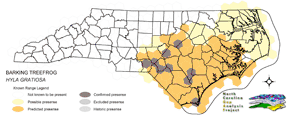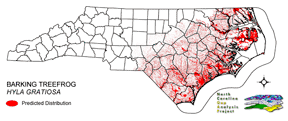
| Taxa: |
| Order: |
| Family: |
| Amphibia |
| Anura |
| Hylidae |
| NatureServe Global Rank: |
| NatureServe State (NC) Rank: |
| G5 |
| S4 |
| Federal Status: |
| NC State Status: |
| --- |
| --- |


| Land Unit |
| US Fish & Wildlife Service |
| US Forest Service |
| US National Park Service |
| US Department of Defense |
| NC State Parks |
| NC University System |
| NC Wildlife Res. Com. |
| NC Forest Service |
| NC Div. of Coastal Mgmt. |
| Local Governments |
| Non-Governmental Org. |
| Other Public Lands |
| Private Lands |
| GAP Status 1-2 |
| All Protected Lands |
| Statewide |
| Hectares |
| 110,148.39 |
| 49,809.06 |
| 66,385.08 |
| 1,414.17 |
| 15,341.22 |
| 22,746.96 |
| 66,403.89 |
| 8,034.21 |
| 8,329.23 |
| 326.79 |
| 20,692.62 |
| 523.17 |
| 1,359,326.43 |
| 220,293.81 |
| 369,661.86 |
| 1,729,481.22 |
| Acres |
| 272,182.55 |
| 123,080.84 |
| 164,041.07 |
| 3,494.49 |
| 37,908.97 |
| 56,208.95 |
| 164,087.55 |
| 19,852.96 |
| 20,581.97 |
| 807.52 |
| 51,132.57 |
| 1,292.78 |
| 3,358,968.11 |
| 544,357.75 |
| 913,454.17 |
| 4,273,640.33 |
| % of Dist. on |
| Prot. Lands |
| 29.8 % |
| 13.5 % |
| 18.0 % |
| 0.4 % |
| 4.2 % |
| 6.2 % |
| 17.9 % |
| 2.2 % |
| 2.3 % |
| 5.6 % |
| 5.6 % |
| < 0.1 % |
| < 0.1 % |
| 59.6 % |
| ----- |
| ----- |
| % of Dist. on |
| All Lands |
| 6.4 % |
| 2.9 % |
| 3.8 % |
| < 0.1 % |
| 0.9 % |
| 1.3 % |
| 3.8 % |
| 0.5 % |
| 0.5 % |
| < 0.1 % |
| 1.2 % |
| < 0.1 % |
| 78.6 % |
| 12.7 % |
| ----- |
| ----- |
|
This species spends most of its life in arboreal retreats in forested habitats. It is both fossorial and arboreal, using tree perches and cavities for shelter during favorable, warm, wet conditions (Conant and Collins 1998, Terwilliger 1991). NATURE SERVE GLOBAL HABITAT COMMENTS: Sandy areas in pine savannas and in low wet woods and swamps (e.g., willow oak-blackgum, cypress swamps). When inactive during cold or dry season, burrows under tree roots, vegetation, or in soil; otherwise mostly arboreal and thus dependent on trees near water. Eggs and larvae develop in shallow water of ponds, swamps, and bayheads; in Virginia, breeding sites were temporary ponds dominated by graminoids, beneath open canopies (Mitchell 1991). Reproduction is more successful in semi-permanent ponds due to the absence of predatory fishes. In some areas, deep ponds, such as Carolina Bays and barrow pits, are preferred breeding sites. |
| Code | Name | Description | NC Natural Heritage Program Equivalent |
| 75 | Tidal Swamp Forest | Swamp tupelo dominated forest with or without black tupelo and/or cypress trees. Restricted to the tidal zones in the coastal plain. May have inclusions of coastal red cedar woodlands. | Tidal cypress - gum swamp |
| 121 | Maritime Pinelands | Loblolly forests and woodlands of the outer coastal plain. | Estuarine Fringe Loblolly Pine Forest |
| 17 | Maritime Forests and Hammocks | Maritime forests and woodlands dominated by live or sand laurel oak. Estuarine Fringe forests dominated by loblolly pine. | Coastal Fringe Evergreen Forest, Maritime Deciduous Forest, Maritime Deciduous Forest |
| 126 | Interdune Wooded Depression Swamp | Includes swamps dominated by sweetbay and swampbay or dogwood dominated forests. | Maritime Shrub Swamp, Maritime Swamp Forest |
| 173 | Coastal Plain Riverbank Shrubs | Shrub dominated riverbanks, commonly dominated by willows and/or alders. | Sand and Mud Bar |
| 50 | Coastal Plain Mixed Bottomland Forests | Includes forests dominated by a variety of hardwood species, including sweetgum, cottonwood, red maple. | Coastal Plain Bottomland Hardwood (in part), Coastal Plain Levee Forest |
| 49 | Coastal Plain Oak Bottomland Forest | Bottomland forests dominated by deciduous oak alliances. Oaks represented can include swamp chestnut, cherrybark, willow, and/or overcup oak. Inclusions of loblolly pine temporarily flooded forests occur in patches. Hydrology is temporarily to seasonally flooded. | Coastal Plain Bottomland Hardwoods (in part) blackwater subtype, brownwater subtype |
| 158 | Coastal Plain Nonriverine Wet Flat Forests | Loblolly pine - Atlantic white-cedar - red maple - swamp tupelo saturated forests as well as forests dominated by loblolly, sweetgum, and red maple in non-riverine flats. | Non-riverine Wet Hardwood Forest |
| 41 | Peatland Atlantic White-Cedar Forest | Dense stands of Atlantic white cedar with saturated hydrology. Can include swamp tupelo, red maple, and pond pines with a moderate shrub and herb layer. | Peatland Atlantic White-Cedar Forest |
| 15 | Seepage and Streamhead Swamps | Includes extensive peat flats in the coastal plain, dominated by swamp tupelo, maples, and Atlantic white cedar alliances. In the sandhills includes streamhead pond pine and bay forests alliances. Saturated hydrology. | Bay Forest, Small Depression Pocosin, Streamhead Atlantic White Cedar Forest, Streamhead Pocosins |
| 30 | Cypress-Gum Floodplain Forests | Swamps dominated by black or swamp tupelo with or without Taxodium. Seasonally to semi-permanently flooded hydrology. | Cypress-Gum Swamps |
| 78 | Pond-Cypress - Gum Swamps, Savannas and Lakeshores | Cypress dominated swamps and lakeshores. Can include bays dominated by pond cypress or shorelines of coastal plain lakes with a narrow band of cypress. | Non-riverine Swamp Forest, Natural Lakeshores (in part) |
| 385 | Oak Bottomland Forest and Swamp Forest | The swamp chestnut oak, cherrybark oak, shumard oak and sweetgum alliance is one representative. Other alliances are dominated by water, willow, and overcup oaks. Swamp forests can be dominated by sweetgum, red maple, and black gum being dominant. Loblolly can occur in combination with sweetgum and red maple, or with tulip poplar. Includes saturated and semi- to permanently flooded forests in the mountains. | Piedmont/Mountain Bottomland Forest, Piedmont/Mountain Swamp Forest |
| 63 | Coastal Plain Mesic Hardwood Forests | Beech dominated forests with white oak and northern red oak as possible co-dominants. Dry-mesic to mesic forests on slopes and small stream bottoms in the coastal plain. | Mesic Mixed Hardwood Forest, Basic Mesic Forests |
| 138 | Coastal Plain Dry to Dry-Mesic Oak Forests | Oak dominated forests of the coastal plain. Includes white oak forests with water oak or northern red oak and hickories as co-dominants. | Dry Mesic Oak Hickory Forest, Basic Oak Hickory Forest, Dry Oak Hickory Forest |
| 87 | Pocosin Woodlands and Shrublands | Includes pond pine woodland, low pocosin and high pocosin shrub dominated areas. Canebrakes and bay forests may be present. | Pond Pine Woodlands, Peatland Canebrake, Small Depression Pocosin |
| 67 | Wet Longleaf or Slash Pine Savanna | Wet flatwoods and pine savannas, typically dominated by longleaf pines, but slash or pond pines may be the dominant pines. | Wet Pine Flatwoods |
| 97 | Mesic Longleaf Pine | Longleaf pine woodlands without a major scrub oak component. Slash or loblolly pines may be present as well. | Mesic Pine Flatwoods |
| 267 | Riverbank Shrublands | Riverside shrubs with temporarily flooded hydrologies. Found in the both the Mountains and Piedmont. Containing dominants such as smooth alder and a Carolina or black willows. | Sand and Mud Bar |
| 269 | Floodplain Wet Shrublands | Saturated shrublands of the Piedmont, includes buttonbush, swamp-loosestrife, decodon and alders. | Piedmont/mountain Semipermanent Impoundment |
| 384 | Piedmont/Mountain Mixed Bottomland Hardwood Forests | Includes temporarily to seasonally forests dominated by hardwood species. Hardwoods include sweetgum, red maple, sycamore which co-occur in a mosaic of bottomland and levee positions. Includes alluvial hardwood forests in the mountains. Hemlock and white pine may occur as inclusions, but are generally mapped separately. | Piedmont/Mountain Alluvial Forest, Piedmont/Mountain Levee Forest |
|
Caldwell, J. P. 1982. Hyla gratiosa. Cat. Am. Amph. Rep. 298.1-298.2.
Terwilliger, K. 1991. Virginia's endangered species. McDonald and Woodward Publishing Co., Blacksburg, VA. 170 pp. Perrill, S. A., and R. E. Daniel. 1983. Multiple egg clutches in HYLA REGILLA, H. CINEREA, and H. GRATIOSA. Copeia 1983:513-516. Conant, R. 1975. A Field Guide to Reptiles and Amphibians of Eastern and Central North America. Second Edition. Houghton Mifflin Company, Boston, Massachusetts. xvii + 429 pp. Mount, R. H. 1975. The Reptiles and Amphibians of Alabama. Auburn University Agricultural Experiment Station, Auburn, Alabama. vii + 347 pp. Behler, J. L., and F. W. King. 1979. The Audubon Society field guide to North American reptiles and amphibians. Alfred A. Knopf, New York. 719 pp. Martof, B. S., W. M. Palmer, J. R. Bailey, and J. R. Harrison, III. 1980. Amphibians and reptiles of the Carolinas and Virginia. University of North Carolina Press, Chapel Hill, North Carolina. 264 pp. Mitchell, J. C. 1991. Amphibians and reptiles. Pages 411-76 in K. Terwilliger (coordinator). Virginia's Endangered Species:Proceedings of a Symposium. McDonald and Woodward Publishing Company, Blacksburg, Virginia. |
For more information please contact them at:
NC-GAP Analysis Project
Dept. of Zoology, NCSU
Campus Box 7617
Raleigh, NC 27695-7617
(919) 513-2853
www.basic.ncsu.edu/ncgap